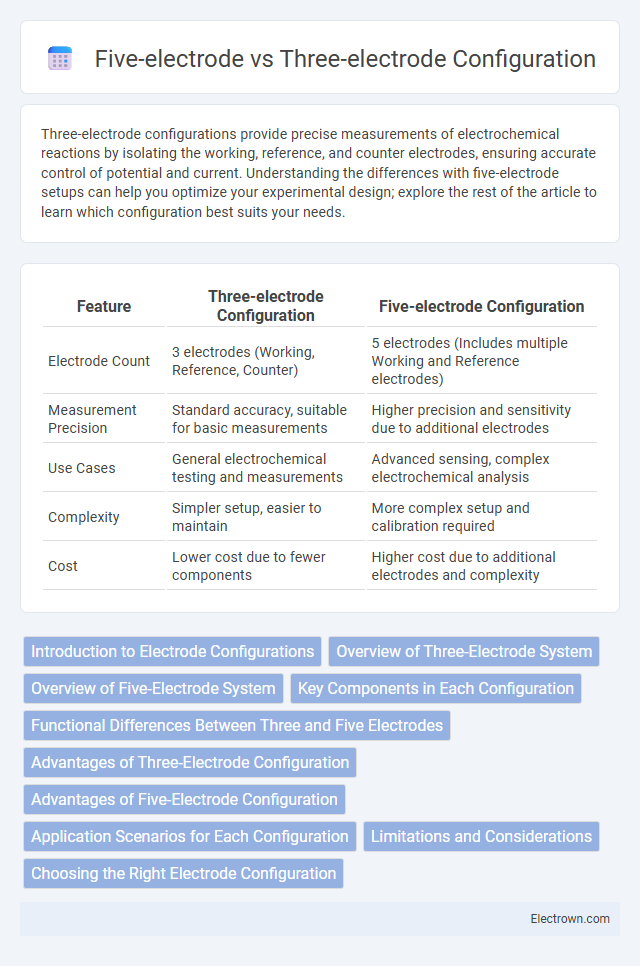Three-electrode configurations provide precise measurements of electrochemical reactions by isolating the working, reference, and counter electrodes, ensuring accurate control of potential and current. Understanding the differences with five-electrode setups can help you optimize your experimental design; explore the rest of the article to learn which configuration best suits your needs.
Table of Comparison
| Feature | Three-electrode Configuration | Five-electrode Configuration |
|---|---|---|
| Electrode Count | 3 electrodes (Working, Reference, Counter) | 5 electrodes (Includes multiple Working and Reference electrodes) |
| Measurement Precision | Standard accuracy, suitable for basic measurements | Higher precision and sensitivity due to additional electrodes |
| Use Cases | General electrochemical testing and measurements | Advanced sensing, complex electrochemical analysis |
| Complexity | Simpler setup, easier to maintain | More complex setup and calibration required |
| Cost | Lower cost due to fewer components | Higher cost due to additional electrodes and complexity |
Introduction to Electrode Configurations
Three-electrode and five-electrode configurations are commonly used in electrochemical systems to measure and control electrode potentials accurately. The three-electrode setup consists of a working electrode, reference electrode, and counter electrode, providing precise control over the working electrode potential and minimizing interference. In contrast, the five-electrode configuration adds two auxiliary electrodes to enhance stability, improve signal quality, and enable more complex measurements in advanced electrochemical studies.
Overview of Three-Electrode System
The three-electrode system consists of a working electrode, a reference electrode, and a counter electrode, enabling precise control and measurement of electrochemical reactions. This configuration is widely used in electrochemical analysis and sensor applications due to its ability to provide accurate potential control and minimize interference from current flow. Understanding the three-electrode setup is essential for optimizing your experiments and obtaining reliable data in electrochemical studies.
Overview of Five-Electrode System
The five-electrode system enhances measurement accuracy by introducing two additional reference electrodes, improving signal stability and reducing noise compared to the traditional three-electrode setup. This configuration is commonly used in advanced electrochemical applications where precise control over working and counter electrodes is crucial. Your experiments benefit from increased reliability and reproducibility due to this optimized electrode arrangement.
Key Components in Each Configuration
A three-electrode configuration consists of a working electrode, a reference electrode, and a counter electrode, where the working electrode is the site of the electrochemical reaction, the reference electrode provides a stable potential, and the counter electrode completes the circuit by allowing current flow. In contrast, the five-electrode configuration includes additional electrodes, such as a second working electrode and a secondary reference or counter electrode, enhancing measurement accuracy and control in complex electrochemical systems. Understanding the key components in your chosen setup ensures precise data acquisition and optimal experimental outcomes.
Functional Differences Between Three and Five Electrodes
The three-electrode configuration primarily includes a working electrode, a reference electrode, and a counter electrode, enabling precise control of the electrochemical potential at the working electrode for accurate measurements. The five-electrode setup introduces two additional electrodes, often auxiliary working electrodes, to enhance sensitivity, selectivity, and simultaneous multi-parameter analysis in complex electrochemical systems. These extra electrodes provide improved control over reaction environments and allow advanced techniques such as dual working electrode methods for studying reaction mechanisms or real-time monitoring of multiple analytes.
Advantages of Three-Electrode Configuration
The three-electrode configuration offers precise control of the working electrode potential by using a reference electrode, which ensures accurate and stable electrochemical measurements. It minimizes potential drop and interference from the counter electrode, enhancing data reliability during experiments such as cyclic voltammetry. Your electrochemical analysis benefits from this setup's simplicity and efficiency, making it ideal for detailed kinetic and mechanistic studies.
Advantages of Five-Electrode Configuration
The five-electrode configuration offers enhanced measurement accuracy by reducing interference and noise, providing more stable and precise data compared to the three-electrode setup. This configuration also improves electrode durability and lifespan due to better current distribution and minimized polarization effects. Its superior signal-to-noise ratio benefits applications requiring high precision, such as advanced electrochemical sensing and bioelectrical studies.
Application Scenarios for Each Configuration
Three-electrode configurations are commonly used in laboratory electrochemical studies and sensor applications requiring precise control of the working electrode potential. Five-electrode setups find their advantage in complex biological or industrial environments where enhanced signal stability and noise reduction are essential, such as in in vivo measurements or corrosion monitoring. Choosing the appropriate configuration depends on Your need for accuracy, environmental interference, and specific application requirements.
Limitations and Considerations
Three-electrode configurations often face limitations such as potential reference electrode drift and limited current range, which can affect measurement accuracy and stability. Five-electrode setups introduce complexity with additional electrodes, requiring precise calibration to manage cross-talk and signal interference. Considerations include balancing system cost, measurement sensitivity, and application-specific requirements to choose the optimal electrode configuration.
Choosing the Right Electrode Configuration
Choosing the right electrode configuration depends on the specific application and desired measurement accuracy. Three-electrode configurations provide precise control and are ideal for electrochemical experiments requiring reference and counter electrodes, while five-electrode setups offer enhanced sensitivity and noise reduction for complex bio-sensing applications. Your choice should balance complexity, signal quality, and the electrochemical process involved to achieve optimal performance.
Three-electrode vs Five-electrode Configuration Infographic

 electrown.com
electrown.com